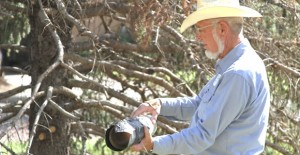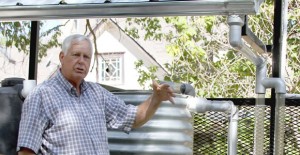Capturing rainwater is one way people can learn to live through drought conditions and meet the need for water, according to speakers at a conference here Saturday.
About 35 people from Donley County, as well as Amarillo and Canyon, attended the seminar that started at the historic Lowe House owned by Sara SoRelle, where volunteers helped install a 1,000-gallon rain collection system.

Billy Kniffen, a water resources specialist from Texas A&M University, led the session and also oversaw the installation of the system that will collect water from 500-square-feet of roof on a garage apartment and divert it for landscape uses.
“We’ve got to learn to get more water or use less water,” Kniffen told those in attendance. “If you want to make a difference, you can. But you have to decide for yourself to do this.”
Kniffen said rainwater collection is catching on in the United States, and some municipalities – San Antonio and Santa Fe – are collection systems be included in certain new constructions. In Texas, all new state buildings are supposed to have rainwater collection systems, he said.
The cost of a system can range from 50 cents per gallon capacity up to $2.25 per gallon depending on the size and intended use of the system.
“We need to start small and grow,” Kniffen said, noting that it’s easy to start with 20-gallon barrel to collect water for pets and plants. “We need to ask what communities can do to encourage rainwater harvesting.”

Kniffen said a simple formula can determine how much rainwater a roof is capable of collecting. About 0.6 gallons of water falls on each square foot of roof area in a one-inch rain. A 1,000-square-foot roof could yield 600 gallons of water for each inch of rainfall.
Kniffen’s home in Menard, Texas, operates totally on rainwater for all uses. He has 25,000 gallons of storage capacity. During last year, from October to October, they received only five inches of rain, but at the end of that period he still had two months of water available.
“We operate on 20 gallons of water per person per day,” he said of his home, which includes several water conservation features, including low-flow toilets, faucet aerators, and landscaping that requires very little water.
Kniffen said metal roofs are the best for collecting rainwater but tile and composition roofs work also. Shake shingles are more problematic. Screens and diversions can keep water collected in roof gutters from washing debris into the storage tanks, and Kniffen recommends black or other tanks that cannot be penetrated by light to prevent algae growth. Tanks can also be painted, decorated, or otherwise modified to blend in better with the landscape of a home or business.
“I want it to look neat,” he said.
Rainwater can be filtered and treated to be consumable by humans, but many people use collected rainwater for non-potable uses in the home, such as for commodes and washing machines, Kniffen said.
“Ten percent of Australians live solely on rainwater, and New Zealand requires all new homes use rainwater for commodes, washers, and landscape irrigation,” Kniffen said.
Local municipalities can set the allowable uses of rainwater in homes.
Alanreed rancher Delbert Trew also spoke at the session and said he has been practicing rainwater harvesting on his land for 18 years. He has not done any rooftop collection, but he has built about 300 catchments – small dams that divert water into the ground – around the tops of gullies and canyons on his property.
Trew said he started his harvesting after he had two wells go dry in his pasture. His efforts paid off over time with about 11 springs now flowing on his ranch where there was only a handful before, and, until last summer, he was able to shut off his windmill wells completely.
Trew also demonstrated how to build and install “tree pipes” to deep water trees and hopefully save them from the effects of the drought. He showed how a four-foot length of four-inch pipe could be cut or drilled and wrapped with landscape fabric and then buried vertically near a tree’s drip line. Tree pipes could be any size and made of almost any material – even cardboard tubes. He said one town had gathered up all the scrap PVC pipe they could find, had the high school ag department cut it into lengths and drill holes in it, and then the city gave the tree pipes away.
Deep tree irrigation gets the water down to the tree’s roots and doesn’t promote the growth of weeds and grass like surface watering does, and the water doesn’t evaporate, Trew said. A slow running hose can then be inserted in the pipe or it can be fed by a rainwater collection system.
SoRelle also demonstrated a young tree that she was using “rock mulching” on – a technique of having a shallow reservoir around a tree filled with large stones to hold water around the tree.
Speakers Saturday all admitted that it has to rain for rainwater collection systems to work, but they pointed out the vast amounts of water that is usually allowed to just runoff of properties and down city streets as wasteful in a time when water has become so precious.
For more information, visit http;//rainwaterharvesting.tamu.edu.


Leave a Reply
You must be logged in to post a comment.